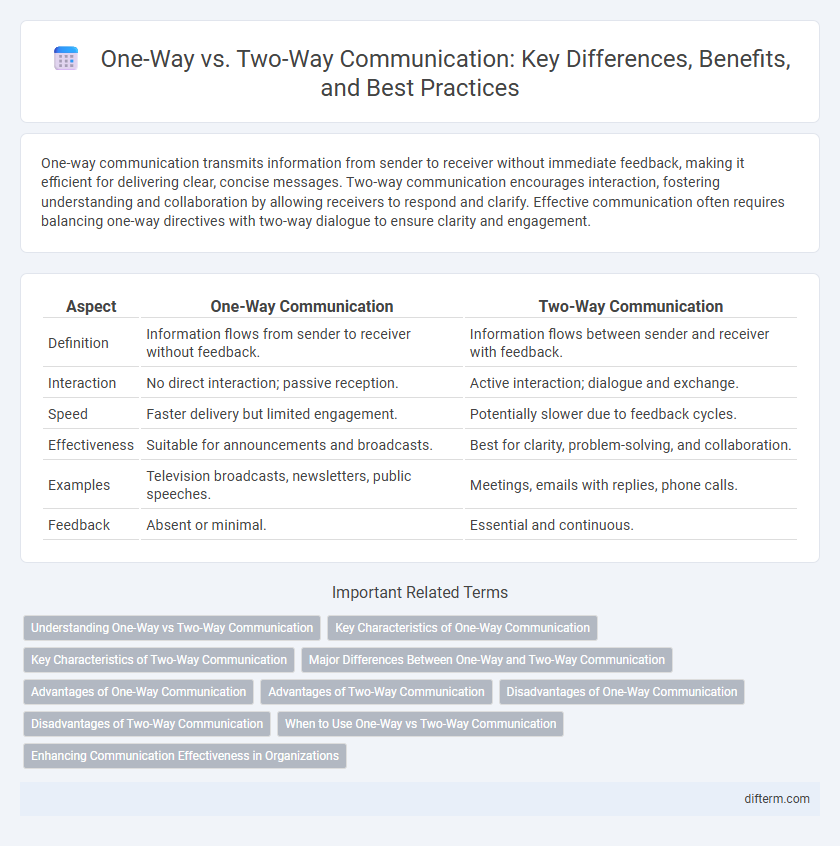One-way communication transmits information from sender to receiver without immediate feedback, making it efficient for delivering clear, concise messages. Two-way communication encourages interaction, fostering understanding and collaboration by allowing receivers to respond and clarify. Effective communication often requires balancing one-way directives with two-way dialogue to ensure clarity and engagement.
Table of Comparison
| Aspect | One-Way Communication | Two-Way Communication |
|---|---|---|
| Definition | Information flows from sender to receiver without feedback. | Information flows between sender and receiver with feedback. |
| Interaction | No direct interaction; passive reception. | Active interaction; dialogue and exchange. |
| Speed | Faster delivery but limited engagement. | Potentially slower due to feedback cycles. |
| Effectiveness | Suitable for announcements and broadcasts. | Best for clarity, problem-solving, and collaboration. |
| Examples | Television broadcasts, newsletters, public speeches. | Meetings, emails with replies, phone calls. |
| Feedback | Absent or minimal. | Essential and continuous. |
Understanding One-Way vs Two-Way Communication
One-way communication involves sending messages without expecting feedback, often used for announcements or instructions where clarity and efficiency are priorities. Two-way communication facilitates interactive dialogue, allowing for immediate feedback, clarification, and enhanced mutual understanding. Effective communication strategies integrate both methods to ensure message accuracy and engagement tailored to audience needs.
Key Characteristics of One-Way Communication
One-way communication transmits information from a sender to a receiver without allowing immediate feedback or interaction, commonly seen in announcements, broadcasts, or emails. It emphasizes clarity, brevity, and consistency to ensure the message is understood despite the absence of response channels. This communication style is efficient for delivering instructions or information to large audiences but may risk misinterpretation due to lack of engagement or questions.
Key Characteristics of Two-Way Communication
Two-way communication is characterized by active feedback, enabling both sender and receiver to exchange information and clarify messages in real time. It fosters mutual understanding, reduces misunderstandings, and supports collaborative problem-solving through interactive dialogue. Key features include responsiveness, message reciprocity, and dynamic adjustment based on participants' reactions.
Major Differences Between One-Way and Two-Way Communication
One-way communication transmits information without expecting immediate feedback, making it efficient for broadcasting messages to large audiences but limiting interaction. Two-way communication enables a dynamic exchange where feedback, questions, and clarifications occur, enhancing understanding and engagement between sender and receiver. The major difference lies in interactivity; one-way messages flow in a single direction, while two-way communication fosters dialogue and active participation.
Advantages of One-Way Communication
One-way communication offers clear and efficient message delivery, minimizing misunderstandings by controlling the flow of information from sender to receiver without interruptions. It is particularly advantageous in situations requiring quick dissemination of instructions or announcements, such as emergency alerts and corporate updates. This method reduces feedback complexity and ensures consistent messaging across large audiences.
Advantages of Two-Way Communication
Two-way communication enhances understanding by enabling immediate feedback and clarification, reducing misinterpretations. It fosters collaboration and engagement, promoting active participation and trust among participants. This dynamic exchange accelerates problem-solving and decision-making, improving overall efficiency and productivity in organizational settings.
Disadvantages of One-Way Communication
One-way communication limits feedback and engagement, resulting in misunderstandings and reduced message clarity. It often leads to decreased employee motivation and collaboration due to the lack of interactive dialogue. Organizations relying heavily on one-way communication may experience ineffective information dissemination and slower problem-solving processes.
Disadvantages of Two-Way Communication
Two-way communication can lead to misunderstandings due to the increased number of participants exchanging messages, which may cause confusion and misinterpretation. It often requires more time and resources to manage feedback and ensure clarity between sender and receiver. Additionally, the complexity of two-way communication can hinder timely decision-making in fast-paced environments.
When to Use One-Way vs Two-Way Communication
One-way communication is most effective for delivering clear, concise information to large audiences or when immediacy is crucial, such as in emergency announcements or official instructions. Two-way communication excels in collaborative environments where feedback, clarification, and engagement enhance understanding and decision-making, like team meetings or customer service interactions. Choosing between one-way and two-way communication depends on the communication goals, audience size, and need for interaction or feedback.
Enhancing Communication Effectiveness in Organizations
One-way communication delivers clear directives and information rapidly but limits feedback, potentially causing misunderstandings in organizational settings. Two-way communication fosters interactive dialogue, enabling clarification and immediate feedback, which enhances employee engagement and collaboration. Organizations leveraging two-way channels achieve higher communication effectiveness, promoting transparency and improving decision-making processes.
one-way vs two-way Infographic

 difterm.com
difterm.com